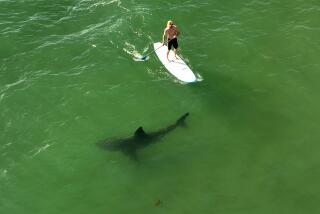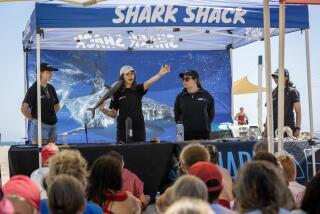No Game : At Tournament, Anglers Aim to Boost Awareness, Not the Harvest, of Vulnerable Mako Sharks
- Share via
About 300 boats will head out to sea from Orange County and other parts of Southern California early Saturday in search of mako sharks.
But the hunters in those boats won’t be looking for steaks or a trophy to stuff and hang on the den wall. Any makos they are skillful or lucky enough to catch will be fitted with a small numbered tag and set free. On the tag is a request that any angler who catches the shark notify the state Department of Fish and Game, which is tracking the makos’ growth and migration patterns.
Sponsored by the United Anglers of Southern California, the two-day mako tag-and-release tournament is an effort to gather information about the little-understood mako and raise public awareness about what many feel is an imminent danger to the shark fishery.
“I started fishing makos about 10 years ago,” said Greg Stotesbury of Newport Beach, who will be one of those on the water this weekend.
“Until a few years ago, there were only four or five guys around here fishing them. But people discovered that they tasted good, and combined with a lack of other big-game fish recently, interest in makos has exploded.”
Although Stotesbury and others are worried about the effect of unrestricted sport fishing on the shark population, they are most concerned about an emerging commercial mako shark fishing industry in an area bounded roughly by Palos Verdes Peninsula, Santa Catalina Island and Point Loma in San Diego.
Two years ago, the state Fish and Game Commission allowed 10 commercial boats to begin fishing for makos with “long lines”--four-mile-long cables strung every 15 feet with baited hooks, a very efficient method of catching sharks.
Twenty percent of their catch has been makos, 60% blue sharks, the rest assorted other fish. The makos are sold to restaurants and fish dealers. The blues are mostly discarded.
But the vast majority of the makos caught are very young fish, according to John Sunada, associate marine biologist with the state Department of Fish and Game.
“We rarely see any makos here older than 3 or 4. The sub-adults tend to hang out here together for a while before going somewhere else.”
Sunada said state biologists are developing a theory that the coastal waters between the mainland and Catalina are a rearing ground for very young mako sharks.
Sunada said some makos tagged in the “nursery” area have been caught later off Baja, Mexico.
“We know that this kind of shark is vulnerable to overfishing and can be overfished quickly. We’re taking a very slow and cautious approach.”
Sunada said the Fish and Game Commission, which approved the experimental commercial mako fishery, will decide later this year whether to continue it, expand it or cancel it.
“We need to know more about the fish before that decision can be made,” he said.
Stotesbury and others who this year formed Concerned Shark Fishermen of Southern California say the state already has allowed for greater fishing of makos than is prudent.
“Our concern is that if they start taking the nursery stock out, the fishery will collapse,” he said. “You’ll catch a lot of sharks for a while and then, because they reproduce so slowly, nothing. Boom and bust.”
Although no figures are available on the shark population in local waters, Stotesbury and other Orange County shark fishermen say they have seen a dramatic decline in the past two years.
Jason Blower of Newport Beach has been fishing for makos for more than eight years. He stalks them alone in a 22-foot boat called Mako Mad. This year he’s seen fewer makos than in any previous year.
The mako is “the most exciting fish that swims,” Blower said. “But I began tagging and releasing them three years ago when I realized all these sharks are juveniles. Allowing commercial fishing in an area like this is like opening deer season for fawns.”
The sport fishermen opposed to the commercial harvest of makos say history has shown that when a specific shark is targeted, its numbers are devastated. They are concerned that the mako will go the way of the thresher and soupfin sharks, species that were once plentiful in Southern California waters but, after intensive commercial fishing, now are seldom seen.
“The mako fishery is too precious,” Stotesbury said. “We need to be more conservative until we understand the biological impact of taking large numbers.”
Stotesbury and his group are lobbying the state Fish and Game Commission to end the commercial shark permits next year.
Even though the numbers of sharks taken by sport fisherman are tiny compared to the commercial haul, Stotesbury and his group have also recommended to the state a two-shark-per-day limit for recreational anglers. Now there are no limits on size or number.
“We have to err on the side of conservation, not exploitation,” Stotesbury said.
He said his group is also assisting state marine biologists in tagging and releasing sharks so information can be accumulated on their movements and habits.
“We’re working hard to discourage the Rambo kind of attitude out there. We’re telling our members they’ve got to release these fish.”
Tom Shanahan of Dana Point, a shark sportfishing boat skipper who participates in the tag-and-release program, said he would support increased regulation of sport shark fishing.
“Let’s put a tax on catching sharks, a surcharge on your license or whatever. That would satisfy the state and generate money for research and enforcement.
“We have to do what it takes because the mako fishery could already be damaged beyond repair in my generation.”
More to Read
Sign up for Essential California
The most important California stories and recommendations in your inbox every morning.
You may occasionally receive promotional content from the Los Angeles Times.










